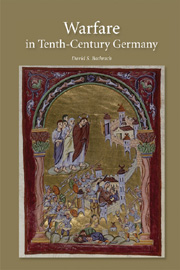Book contents
- Frontmatter
- Contents
- List of Illustrations
- Acknowledgments
- Abbreviations
- Introduction
- 1 Restoring Francia Orientalis: Henry I's Long Term Strategy
- 2 Forging a New Empire
- 3 Military Organization
- 4 Military Education
- 5 Arms and Training
- 6 Morale
- 7 Tactics on the Battlefield
- 8 Campaign Strategy: The Civil War of 953–954
- Conclusion
- Appendix: Major Military Operations by Henry I, Otto I, and Their Commanders
- Bibliography
- Index
- Warfare in History
3 - Military Organization
Published online by Cambridge University Press: 05 February 2013
- Frontmatter
- Contents
- List of Illustrations
- Acknowledgments
- Abbreviations
- Introduction
- 1 Restoring Francia Orientalis: Henry I's Long Term Strategy
- 2 Forging a New Empire
- 3 Military Organization
- 4 Military Education
- 5 Arms and Training
- 6 Morale
- 7 Tactics on the Battlefield
- 8 Campaign Strategy: The Civil War of 953–954
- Conclusion
- Appendix: Major Military Operations by Henry I, Otto I, and Their Commanders
- Bibliography
- Index
- Warfare in History
Summary
The military campaigns of Henry I and Otto I, which focused largely on the capture and defense of fortifications, required the deployment of large armies over long periods. Concomitantly, protecting both the frontiers and internal regions with extensive networks of strongholds, including many fortress cities of Roman origin, required the mobilization of very large numbers of men for local defense. The core of the Ottonian armies on campaign consisted of the royal military household, and professional fighting men provided by lay and ecclesiastical magnates. However, the numerically preponderant element of these armies on campaign was provided by men of the expeditionary levy. The local defense was undertaken by all able-bodied men in a region, which included both professional soldiers in the area, and large numbers of men drawn from all walks of life, and every social status.
Writing from his vantage point in the early eleventh century, Bishop Thietmar of Merseburg presented contemporary military organization as comprising three separate elements: the general levy that was organized for local defense, the expeditionary/select levies of militia forces that were deployed beyond the boundaries of their local region, and the professional military households of ecclesiastical and secular magnates, including the royal military household. Readers familiar with Carolingian military organization will note the similarity between this system and the military forces available to the rulers of the regnum Francorum.
Thietmar's views regarding the military organization of the Ottonian kingdom were based upon his own broad experiences as an advisor to Henry II (10027ndash;1024) and his service as a military commander under this king.
- Type
- Chapter
- Information
- Warfare in Tenth-Century Germany , pp. 70 - 101Publisher: Boydell & BrewerPrint publication year: 2012

